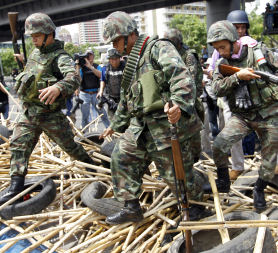Thailand protests: how did we get here?
Updated on 19 May 2010
Asia correspondent Nick Paton Walsh explains why the red shirts are protesting in Thailand, and the politics that led to today's military operation against them.

How did this start? The simplest explanation is that Thai society is deeply divided, into old rich and elite versus new rich and poor.
Politics here vacillates between two groups. First are the yellows: the establishment with its support from the military hierarchy and those linked to the monarchy.
On the other side are the reds: this group was given political muscle by Thaksin Shinawatra - a billionaire mobile phone magnate who became prime minister. He gave succour to the rural poor, and also launched an aggressive war on drugs in which allegations about hundreds of extrajudicial executions flew.
Power transfers
Over the past decade, power has swung between these two sides like a pendulum. Thaksin was deposed in September 2006 by a coup, but that was Thailand's 18th coup in 80 years: the military stepping in often to provide what they see as stability when the warring political classes will not.
More Channel 4 News coverage of the Thailand protests:
- Thai army moves to take over protest camp
- Thailand: renegade 'red shirt' general dies
- Blog: methodical crackdown has changed the city
- More blogs from Nick Paton Walsh in Bangkok
An ally, Somchai Wongsawat, became prime minister in September 2008, but resigned 3 months later, after his appearances as a celebrity chef whilst in power were judged to be a breach of rules.
The current prime minister, Abhisit Vejjajiva, took over after a parliamentary vote in November 2008.
The red protests do not consider Abhisit elected, but that he came to power through a slight of democratic hand. The protests began when courts stripped the considerable assets of Thaksin, suggesting they had been acquired illegally during his time in power.
But what began as a minor cult of personality soon became something more sizeable, less controllable.
Real power
The number of leaders that the reds answered to rose to around 34 at one point, and more importantly the thousands of people on the ground, down in Ratchaprasong, realised that as they sat there, clogging up the most important commercial part of the city - to many the real symbol of the economic dream in which only a few could partake - they had real power. Real power.
As dusk fell on this part of the city, the most vivid symbol of that economic boom, the Central World Shopping centre, the biggest one in South East Asia, is in flames and may collapse entirely.
You can draw from that your own metaphor about how Thailand's self-image as a democratic, harmonious land of the free stands tonight.





